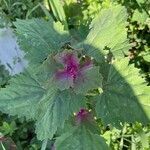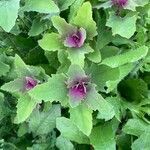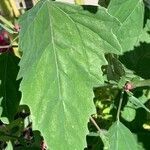Erect annual herb to c. 1 m tall, non-aromatic, eglandular; young parts farinose with the vesicular hairs light violet-purple, becoming efarinose. Petiole to 9 cm long, often purple; lamina 1-3× petiole, 4-11-(16) × 4-11-(12) cm, broadly triangular, sometimes almost rhombic, coarsely and irregularly dentate; teeth acute; base broad-cuneate to truncate; apex obtuse, mucronate, or ± acute; infl. lvs smaller, ± oblong-ovate. Infls paniculate, with terminal and axillary branches; glomerules rather small, globular, few-flowered, strongly farinose. Perianth segments 0.5-1.1 mm long, broad and imbricate, green or purplish on back with broad dorsal hyaline margin, keeled, fused for nearly 1/2 length. Fr. invested by perianth; pericarp easily removed. Seed horizontal, mostly 1.2-1.4 mm diam., circular, compressed; margin obtuse; testa glossy black, very faintly striated.
Annual herb, up to 2 m high. Stems erect; young shoots and young leaves suffused purplish pink. Leaves petiolate; blade broadly ovate to rhomboid, up to 200 x 160 mm, usually > 45 mm wide, with many, ± shallow teeth, surfaces with mealy, vesicular hairs. Flowers: in a terminal panicle of many, spicately arranged flower clusters; green or reddish; Jan.-Mar. Seeds bluntly keeled, surface black, shining.
Leaves (of inferior and middle parts of stem and branches) broadly rhombic-ovate, large, (5) 10–18 × (4.5) 10–16 cm., broadly cuneate-attenuate at base, rounded at apex; margins with about 15–30 shallow irregular teeth or lobes on each side, lowermost teeth or lobes not especially prominent; upper leaves and bracts becoming smaller narrower and subacute to acute at apex.
Pericarp somewhat persistent, but easily rubbed or scraped off. Seeds black, shining, about 1–1.2 mm. in diam., bluntly keeled; testa (seen under microscope) marked with numerous irregular spaced radial furrows and with minor irregularities on surface between furrows, but giving a generally smoothish appearance.
A large annual herb. It grows up to 3 m tall. It spreads to 90 cm wide. The leaves are triangle shaped. The leaves are 15 cm long. The shoots are much branched. They have a purple tip. The flower clusters are purple. The seeds are 1.5 mm across and black.
Annual herb closely related to C. album, c. 1–3 m. high, erect, much branched, with young shoots suffused with a conspicuous vivid amaranth-purple, and densely clothed with mealy vesicular hairs; stems red-striped.
Erect annual herb, up to 2 m high. Leaves broadly ovate to rhomboid, usually wider than 45 mm, with numerous ± shallow teeth. Flowers in a terminal panicle. Flowers green.
Inflorescence an ample panicle of very numerous small spicately arranged flower-clusters (“glomerules”) 2–3 mm. in diam.; flowers green or reddish, 0.75–1.5 mm. in diam.
Perianth segments 5, papillose with grey-mealy hairs outside, each with a prominent green keel in upper part.
Stamens 5.



